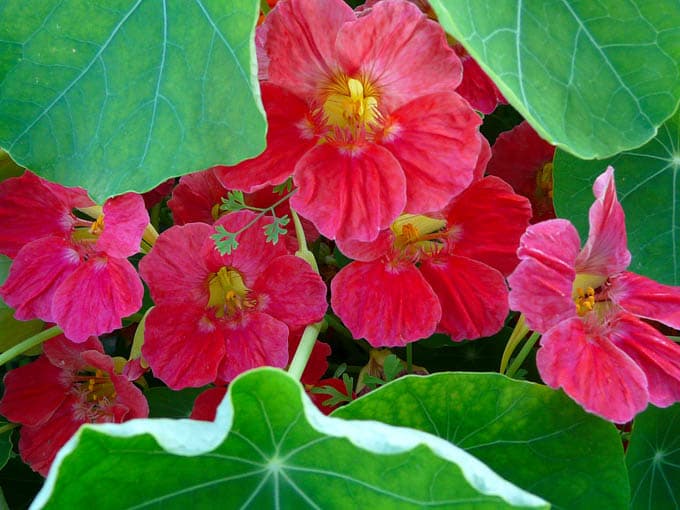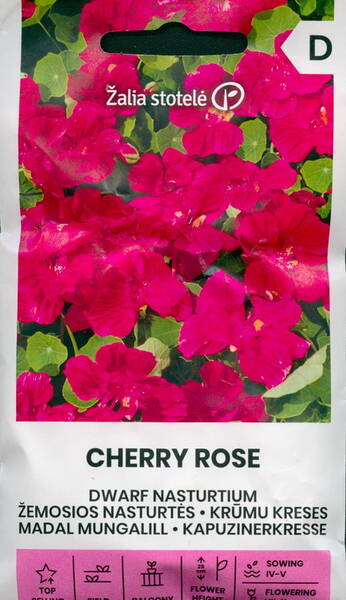Black Friday!
Discount on all products -23% only November 28-30!
Delicate, double, light cherry flowers!
The unpretentiousness and brightness of flowering, along with a pleasant aroma, made this variety of nasturtium extremely popular: the spectacular flowers with spurs of this dwarf beauty simply radiate with cherry-pink lights against a background of lush greenery, decorating balconies, flower beds and flower beds throughout the summer.
Sowing: before sowing, the seeds are soaked for a day in a small amount of water, pre-filled with hot water (+40+50°C). Planted in open ground at the end of May at a distance of 12-25 cm from each other.
Care: Nasturtium prefers moderately fertile, light, well-drained soil and watered early in growth. Top dressing should be carried out only before flowering with an interval of 7-10 days with a solution of complex mineral fertilizer.
Flowering: June to frost.

Dwarf Nasturtium.
* Few people know that nasturtium has remarkable medicinal properties.
In its native South America, it is used for almost a hundred diseases, and it is highly respected in European medicine.
All above-ground parts of nasturtium are exceptionally rich in vitamin C. Its content in fresh nasturtium leaves reaches 450 mg%, and in plant stems up to 100-150 mg% (for comparison, black currants and peppers contain about the same amount, and lettuce leaves - 10 times less).
Nasturtium is also rich in carotene and sulfur, which have a preventive effect on sclerosis and other diseases that affect the elderly. It contains a lot of iodine, potassium, phosphorus.
Nasturtium has a detrimental effect on pathogenic microbes, improves metabolic processes, stimulates the body's defenses.
All parts of the plant are used for medicinal purposes. Nasturtium leaves have a strong antiscorbutic effect. It is used for flu, as an anti-cold remedy, for diseases of the lungs and upper respiratory tract, for chronic bronchitis, because it contains herbal antibiotics.
It is useful for metabolic disorders, for kidney stone and gallstone diseases, as a laxative, for inflammatory diseases of the lymph nodes. It is used for male and female menopause. And dried leaves and flowers relieve depression, a feeling of oppression and irritability. To prepare an infusion, take 1 tbsp. spoon of crushed leaves, pour 1 glass of boiling water, leave for 30 minutes, strain. Take 0.3 glasses 3 times a day. In Western European countries, wine infusion of nasturtium leaves is widely used. To prepare it, fill a liter jar to the top with fresh nasturtium leaves, pour dry white wine over it, close the lid, leave in a dark place at room temperature for 2 weeks, strain. Take 1 teaspoon 3 times a day before meals when the body's vital forces are weakened.
For kidney and urinary tract diseases, as well as urolithiasis, use a decoction of the whole plant. To prepare it, pour 1 tbsp. of leaves, buds and fruits with 0.5 liters of boiling water, heat in a water bath for 15 minutes, leave for 45 minutes, strain. Take 0.5 cups 3 times a day.
For chronic bronchitis, take nasturtium juice 1 tbsp. 3 times a day. For the same purposes, use an alcohol tincture of the whole plant. To prepare it, you need 1.5 tbsp. spoons of crushed leaves with buds and seeds pour 1 glass of vodka, insist in a dark place for 14 days, shaking occasionally. Take 25 drops 3 times a day. And the infusion of nasturtium flowers is used mainly for diseases of the cardiovascular system. Nasturtium is widely used to treat stomatitis. To prepare a decoction, 1 tbsp. spoon of crushed leaves and flowers should be poured with 1 glass of boiling water, heated in boiling water for more than 30 minutes, strain. Add 1 teaspoon of honey to the decoction and rinse the mouth. The same remedy is used to gargle with sore throat. Juice from nasturtium leaves is used externally for itching and scabies, and also as a remedy against hair loss. A decoction of nasturtium leaves and fruits, as well as an alcohol tincture of nasturtium leaves and nettles, also help well against hair loss.
In addition to its high decorative value, medicinal value and high taste qualities, nasturtium also heals the soil from fungal diseases.
And in cooking, this plant is simply irreplaceable. Fresh nasturtium leaves, hard flower buds and unripe seeds are used as food.
In English-speaking countries, nasturtium is widely used to prepare vitamin salads and vitamin drinks.
Fresh leaves, hard flower buds, unripe green seeds have a pleasant spicy taste and are used as seasonings for salads, meat and boiled dishes.
Flower buds and green fruits are marinated with dill and vinegar.
Nasturtium petals, ground with garlic to a paste, with a small addition of salt and mayonnaise can be used as an original paste for sandwiches. The lightly scented, bright yellow flowers of nasturtium are placed on dishes with vegetable platters, fruit casseroles or other cold appetizers. Dried flowers are added to homemade wines, and aromatic tea is made from them.
And finally, dried, peeled and ground nasturtium seeds have a spicy peppery taste and are used as a seasoning for a wide variety of dishes.













